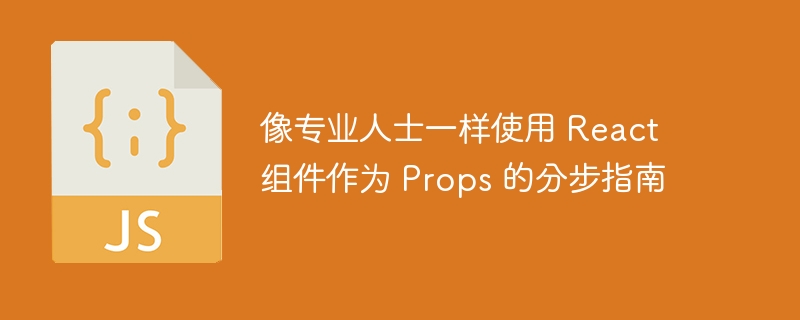像专业人士一样使用 React 组件作为 Props 的分步指南

从初学者到专业人士:将 react 组件理解为 props
作为 react 开发人员,您经常会遇到需要将 react 组件作为 prop 传递给另一个组件的情况。这项技术可能非常强大,但了解正确的方法至关重要,以避免常见的陷阱。在这份详细指南中,我们将探索使用 react 组件作为 props 的最佳实践,从基础知识到高级用例。
了解基础知识
在 react 中,组件可以像任何其他数据类型(例如字符串、数字或对象)一样作为 props 传递。这允许您的应用程序具有高度的灵活性和可重用性。
要将 react 组件作为 prop 传递,您只需将该组件分配给父组件中的 prop,然后在子组件中使用该 prop。这是一个简单的例子:
// parent component
import childcomponent from './childcomponent';
const parentcomponent = () => {
return <childcomponent mycomponent={<mycustomcomponent />} />;
};
// child component
const childcomponent = (props) => {
const mycomponent = props.mycomponent;
return <mycomponent />;
};
// custom component
const mycustomcomponent = () => {
return <div>this is a custom component!</div>;
};
在此示例中,parentcomponent 将自定义 mycustomcomponent 作为 mycomponent 属性传递给 childcomponent。然后,childcomponent 使用 mycomponent 变量渲染传递的组件。
处理动态组件
将组件作为 props 传递的强大用例之一是渲染动态组件的能力。这意味着传递的组件可以根据应用程序中的某些条件或状态进行更改。
以下是如何使用此技术的示例:
// parent component
import { usestate } from 'react';
import dynamiccomponent from './dynamiccomponent';
const parentcomponent = () => {
const [componenttype, setcomponenttype] = usestate('a');
const togglecomponent = () => {
setcomponenttype(componenttype === 'a' ? 'b' : 'a');
};
return (
<div>
<button onclick={togglecomponent}>toggle component</button>
<dynamiccomponent component={componenttype === 'a' ? componenta : componentb} />
</div>
);
};
// dynamic component
const dynamiccomponent = (props) => {
const component = props.component;
return <component />;
};
// custom components
const componenta = () => {
return <div>this is component a</div>;
};
const componentb = () => {
return <div>this is component b</div>;
};
在此示例中,parentcomponent 维护一个状态变量 componenttype,用于确定在 dynamiccomponent 中渲染哪个组件。当单击“toggle component”按钮时,组件类型将被切换,dynamiccomponent 将根据其接收到的 prop 渲染适当的组件。
将 pros 传递给嵌套组件
将组件作为 prop 传递时,您可能还需要将其他 prop 传递给嵌套组件。这可以通过将组件包装在一个函数中来完成,该函数接受必要的 props 并返回该组件。
这是一个例子:
// parent component
import childcomponent from './childcomponent';
const parentcomponent = () => {
return <childcomponent mycomponent={(props) => <mycustomcomponent {...props} />} />;
};
// child component
const childcomponent = (props) => {
const mycomponent = props.mycomponent;
return <mycomponent message="hello, world!" />;
};
// custom component
const mycustomcomponent = (props) => {
return <div>{props.message}</div>;
};
在此示例中,parentcomponent 将一个函数作为 mycomponent 属性传递给 childcomponent。该函数采用必要的 props(在本例中为 message props)并返回带有这些 props 的 mycustomcomponent。
转发参考文献
在某些情况下,您可能需要将引用转发给作为 prop 传递的组件。这可以使用forwardref高阶组件来实现。
这是一个例子:
// parent component
import { useref } from 'react';
import childcomponent from './childcomponent';
const parentcomponent = () => {
const myref = useref(null);
const handleclick = () => {
myref.current.focus();
};
return (
<div>
<childcomponent mycomponent={forwardedcomponent} ref={myref} />
<button onclick={handleclick}>focus input</button>
</div>
);
};
// child component
const childcomponent = forwardref((props, ref) => {
const mycomponent = props.mycomponent;
return <mycomponent ref={ref} />;
});
// forwarded component
const forwardedcomponent = forwardref((props, ref) => {
return <input type="text" ref={ref} />;
});
在此示例中,parentcomponent 将 forwardedcomponent 作为 prop 传递给 childcomponent。 childcomponent 使用forwardref 高阶组件将ref 转发到forwardedcomponent。这允许 parentcomponent 通过调用 ref 上的 focus() 方法来聚焦输入元素。
记住传递的组件
将组件作为 prop 传递时,考虑性能影响非常重要。如果传递的组件的渲染成本很高,那么最好使用 react.memo 高阶组件来记忆它。
这是一个例子:
// Parent Component
import { useState, memo } from 'react';
import ChildComponent from './ChildComponent';
const ParentComponent = () => {
const [count, setCount] = useState(0);
const MemoizedMyComponent = memo(MyComponent);
return (
<div>
<ChildComponent myComponent={<MemoizedMyComponent count={count} />} />
<button onClick={() => setCount(count + 1)}>Increment</button>
</div>
);
};
// Child Component
const ChildComponent = (props) => {
const MyComponent = props.myComponent;
return <MyComponent />;
};
// Memoized Component
const MyComponent = ({ count }) => {
console.log('MyComponent rendered');
return <div>Count: {count}</div>;
};
在此示例中,parentcomponent 使用 react.memo 高阶组件来记忆 mycomponent。这确保了 mycomponent 仅在其 props 更改时重新渲染,从而提高了应用程序的整体性能。
结论
将 react 组件作为 props 传递是一项强大的技术,可以让您的应用程序具有更大的灵活性和可重用性。通过遵循本指南中概述的最佳实践,您可以有效地使用此功能来创建动态、高效且可扩展的 react 应用程序。
在将组件作为 props 传递时,请记住考虑性能、引用转发和动态组件渲染等因素。通过对这些概念的深入理解,您将能够很好地掌握使用 react 组件作为 props 的艺术。
以上就是像专业人士一样使用 React 组件作为 Props 的分步指南的详细内容,更多请关注硕下网其它相关文章!
